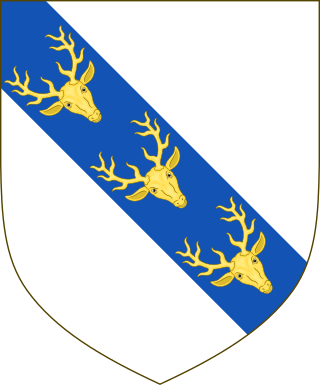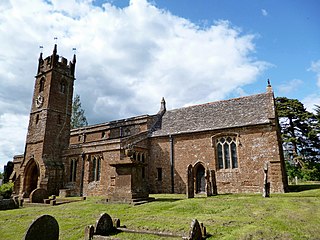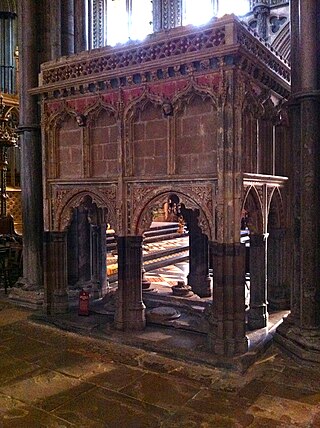
Robert de Vere, 9th Earl of Oxford, KG was a favourite and court companion of King Richard II of England. He was the ninth Earl of Oxford and the first Duke of Ireland and the only Marquess of Dublin. He was also the first person to be created a Marquess.
The Lord High Chancellor of Ireland was the highest judicial office in Ireland until the establishment of the Irish Free State in 1922. From 1721 to the end of 1800, it was also the highest political office of the Irish Parliament: the Chancellor was Speaker of the Irish House of Lords. The Lord Chancellor was also Lord Keeper of the Great Seal of Ireland. In all three respects, the office mirrored the Lord High Chancellor of Great Britain.

Sir John Stanley, KG of Lathom, near Ormskirk in Lancashire, was Lord Lieutenant of Ireland and titular King of Mann, the first of that name. He married a wealthy heiress, Isabel Lathom, which, combined with his own great abilities, allowed him to rise above the usual status of a younger son.

The Dean of St Patrick's Cathedral is the senior cleric of the Protestant St Patrick's Cathedral, Dublin, elected by the chapter of the cathedral. The office was created in 1219 or 1220, by one of several charters granted to the cathedral by Archbishop Henry de Loundres between 1218 and 1220.
The Chancellor of the Exchequer of Ireland was the head of the Exchequer of Ireland and a member of the Dublin Castle administration under the Lord Lieutenant of Ireland in the Kingdom of Ireland. In early times the office was sometimes called the Chancellor of the Green Wax. In the early centuries, the Chancellor was often a highly educated cleric with knowledge of Finance. In later centuries, when sessions of Parliament had become regular, the Chancellor was invariably an MP in the Irish House of Commons. Walter de Kenley, Chancellor from 1292 until his death, was both a judge of the Court of Common Pleas (Ireland) and a distinguished military commander who gave good service against the Gaelic clans of County Wicklow.
James Butler, 3rd Earl of Ormond, was a noble in the Peerage of Ireland. He acceded to the title in 1382, and built Gowran Castle three years later in 1385 close to the centre of Gowran, making it his usual residence, whence his common epithet, The Earl of Gowran.
Events from the year 1318 in Ireland.
Events from the year 1308 in Ireland.

Balscote or Balscott is a village in the civil parish of Wroxton, Oxfordshire, about 4 miles (6.4 km) west of Banbury. The Domesday Book of 1086 records the place-name as Berescote. Curia regis rolls from 1204 and 1208 record it as Belescot. An entry in the Book of Fees for 1242 records it as Balescot. Its origin is Old English, meaning the cottage, house or manor of a man called Bælli.

John Hotham was a medieval Chancellor of the Exchequer, Lord High Treasurer, Lord Chancellor and Bishop of Ely. He was also the effective Governor of Ireland for a time.
Events from the year 1341 in Ireland.
Events from the year 1335 in Ireland.

Sir Henry Redford or Retford was a Knight of the Shire, Sheriff of Lincolnshire and the Speaker of the House of Commons.
Sir Robert Crull (1349–1408) was the Treasurer of Ireland during the reigns of Richard II and Henry IV. Crull is an important figure in the history of English Ireland during the reign of Richard II (1382–1399) for two reasons: his involvement in the antagonism between the Geraldine and Butler families at its most notorious stage, and being at times a sacrificial lamb in Richard II's power struggle with the English Parliament over the stormy colonial politics that ensued.

Sir Robert de Ashton, also called Robert Assheton or Robert de Assheton, was a civil, military, and naval officer under Edward III of England who achieved distinction alike in court and camp, both by land and by sea.

Alexander de Balscot, also known as Alexander Petit was one of the leading Irish clerics and statesmen of the late fourteenth century, who held the offices of Bishop of Ossory, Bishop of Meath, Treasurer of Ireland and Lord Chancellor of Ireland.
Nicholas de Balscote was an English-born official and judge in fourteenth-century Ireland. He attained high judicial office, but his career was damaged by a quarrel with King Edward II.
Events from the year 1687 in Ireland.
John de Pembroke was a Welsh-born judge who held several senior offices in Ireland, including that of Chancellor of the Exchequer of Ireland.








